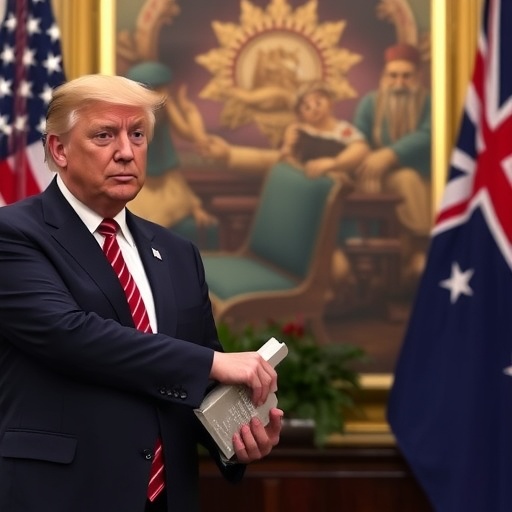Trump’s Firm Endorsement Signals Unwavering Commitment to AUKUS Pact
In a decisive statement that has reverberated across global defense circles, President Donald Trump has confirmed that the AUKUS submarine sales agreement remains firmly on track, underscoring the enduring strength of the trilateral security partnership between the United States, the United Kingdom, and Australia. Delivered during a high-profile address at the Pentagon on Tuesday, Trump’s remarks come at a pivotal moment when geopolitical tensions in the Indo-Pacific region are escalating, with China’s assertive military maneuvers casting a long shadow over regional stability.
- Trump’s Firm Endorsement Signals Unwavering Commitment to AUKUS Pact
- Unpacking the AUKUS Submarine Deal: From Virginia-Class to SSN-AUKUS Innovation
- Australia’s Strategic Pivot: Bolstering Defense Posture in a Volatile Region
- Global Ripples: UK Joins the Fray in Reinforcing Trilateral Bonds
- Navigating Challenges: Production Hurdles and Geopolitical Headwinds
- Looking Ahead: Milestones That Could Redefine Indo-Pacific Security
“The AUKUS deal is not just proceeding—it’s accelerating,” Trump declared, his voice carrying the weight of renewed American leadership in international alliances. “We’re building the most advanced submarines the world has ever seen, and Australia will be at the forefront. This is about defense, deterrence, and delivering on promises to our closest allies.” The announcement quells months of speculation fueled by bureaucratic delays and international scrutiny, reaffirming that the multi-billion-dollar initiative to equip Australia with nuclear-powered submarines is proceeding without interruption.
The AUKUS pact, unveiled in September 2021 under the Biden administration but now revitalized under Trump’s stewardship, represents a cornerstone of Western strategy to counterbalance China’s growing naval dominance. At its heart is the transfer of up to eight Virginia-class submarines from the U.S. to Australia, followed by the co-development of a new SSN-AUKUS class vessel. This isn’t merely a transaction; it’s a strategic fusion of technology, intelligence, and military might designed to reshape the balance of power in one of the world’s most contested waterways.
Trump’s confirmation arrives against a backdrop of intense diplomatic activity. Just weeks ago, Australian Prime Minister Anthony Albanese visited Washington, where discussions centered on streamlining the submarine pathway. Sources close to the negotiations reveal that Trump’s team has fast-tracked approvals, addressing earlier concerns over U.S. submarine production capacity, which has been strained by domestic needs. The U.S. Navy currently operates 49 attack submarines, but plans to expand to 66 by 2030 highlight the urgency of balancing commitments abroad with homeland security.
Unpacking the AUKUS Submarine Deal: From Virginia-Class to SSN-AUKUS Innovation
Diving deeper into the mechanics of the AUKUS submarine sales, the agreement outlines a phased approach that blends immediate capabilities with long-term technological sovereignty. In the initial phase, Australia is set to acquire three to five Virginia-class nuclear-powered attack submarines, valued at an estimated $3 billion each, with deliveries slated to begin in the late 2030s. These stealthy vessels, powered by nuclear reactors that allow for extended underwater operations without surfacing, boast a displacement of 7,800 tons and can reach speeds exceeding 25 knots while armed with Tomahawk cruise missiles and advanced sonar systems.
But the true game-changer lies in the SSN-AUKUS program, a bespoke design integrating British and American nuclear propulsion technology with Australian combat systems. This sovereign submarine, expected to enter service in the 2040s, will feature enhanced stealth features, modular payloads, and AI-driven autonomy, making it a formidable asset against adversarial fleets. Defense analysts estimate the total cost of the AUKUS submarine initiative could surpass $200 billion over three decades, a figure that Trump touted as “an investment in peace through strength.”
To contextualize the scale, consider Australia’s current submarine fleet: six aging Collins-class diesel-electric boats, commissioned in the 1990s, which are increasingly outmatched in an era of blue-water naval warfare. The AUKUS deal replaces a previous $90 billion contract with France for conventional submarines, a move that sparked diplomatic friction in 2021 but has since been vindicated by the pact’s strategic depth. U.S. officials, speaking on condition of anonymity, noted that the Virginia-class transfers will involve rigorous training for over 1,000 Australian personnel, ensuring seamless integration into joint operations.
Statistics underscore the deal’s magnitude. According to a recent report by the Center for Strategic and International Studies (CSIS), nuclear-powered submarines like those in AUKUS can patrol for months without refueling, providing Australia with unprecedented reach into the South China Sea and beyond. This capability is crucial as China’s submarine fleet has grown to over 60 vessels, including advanced Type 093B nuclear attack subs, prompting allies to bolster their undersea defenses.
Australia’s Strategic Pivot: Bolstering Defense Posture in a Volatile Region
For Australia, the AUKUS submarine sales represent a profound shift in its defense architecture, transforming it from a regional player into a pivotal Indo-Pacific powerhouse. Prime Minister Albanese hailed Trump’s confirmation as “a milestone that secures our nation’s future,” emphasizing how the submarines will enhance Australia’s ability to deter aggression and protect vital sea lanes. In a region where 80% of global trade by volume passes through, including critical energy supplies to Australia, the stakes couldn’t be higher.
The Australian government has already allocated $10 billion in upfront funding for infrastructure at Osborne Shipyard in South Australia, where the SSN-AUKUS boats will be assembled. This not only promises thousands of high-tech jobs—projected to create 20,000 positions over the program’s lifespan—but also fosters a domestic industrial base capable of sustaining future naval innovations. Critics, however, point to challenges: the environmental impact of nuclear propulsion and the need for stringent non-proliferation safeguards under the Treaty of Rarotonga, which bans nuclear weapons in the South Pacific.
Trump’s endorsement also aligns with broader U.S. defense priorities. In his speech, he referenced the QUAD alliance (U.S., Australia, Japan, India) and exercises like Talisman Sabre, where Australian forces have integrated with American submarine operations. A 2023 Pentagon assessment revealed that joint AUKUS drills have improved interoperability by 40%, allowing for real-time data sharing on underwater threats. Australian defense experts, such as Hugh White from the Australian National University, argue that without AUKUS, Australia’s strategic vulnerability would expose it to coercion, echoing historical tensions during the 2016 South China Sea arbitration.
Moreover, the pact extends beyond hardware. It includes cyber defense collaborations and intelligence fusion centers, with Australia gaining access to U.S. Five Eyes network enhancements tailored for submarine warfare. As one Australian naval officer put it in a recent interview, “These submarines aren’t just ships; they’re the eyes and ears of our sovereignty in a neighborhood that’s getting more crowded by the day.”
Global Ripples: UK Joins the Fray in Reinforcing Trilateral Bonds
The United Kingdom’s role in AUKUS cannot be overstated, as it brings its Astute-class submarine expertise to the table, paving the way for seamless technology transfers. British Prime Minister Keir Starmer issued a statement welcoming Trump’s confirmation, stating, “AUKUS exemplifies the unbreakable Special Relationship across the Anglosphere, united in purpose against shared threats.” The UK’s contribution includes rolling out its nuclear propulsion designs by the early 2030s, ensuring that the SSN-AUKUS platform benefits from decades of Royal Navy innovation.
This trilateral synergy is already yielding dividends. In a landmark 2024 agreement, the three nations established a joint submarine college in Perth, Australia, training crews in nuclear operations and tactical simulations. The UK’s defense ministry reports that AUKUS has accelerated its own submarine recapitalization, with plans to build five new boats by 2040, partly funded through collaborative R&D savings estimated at £2 billion.
Internationally, reactions are mixed. France, still smarting from the 2021 contract cancellation, has cautiously supported the deal’s progress, while Indonesia and Malaysia express concerns over an arms race. Yet, a poll by the Lowy Institute in Sydney found 62% of Australians back AUKUS, viewing it as essential for national security amid China’s military budget, which hit $292 billion in 2023—surpassing Australia’s entire defense spend.
Trump’s comments also touched on economic benefits, noting that U.S. firms like General Dynamics Electric Boat will see a surge in orders, boosting employment in Connecticut and Virginia. This domestic angle resonates, as the deal aligns with Trump’s ‘America First’ ethos while projecting power abroad.
Navigating Challenges: Production Hurdles and Geopolitical Headwinds
Despite the optimism, the AUKUS submarine sales face tangible obstacles. U.S. production lines are bottlenecked, with the Government Accountability Office warning of delays in Virginia-class builds due to supply chain issues and workforce shortages. Trump acknowledged this, pledging an additional $4 billion in the FY2025 defense budget to expand shipyards, a move that could shave years off timelines.
Geopolitically, China’s response has been pointed. Beijing’s foreign ministry labeled AUKUS “a provocation that destabilizes the region,” prompting increased patrols near Australian waters. In retaliation, Australia has enhanced its AUKUS commitments with hypersonic missile acquisitions from the U.S., further intertwining the allies’ defense ecosystems.
Non-proliferation remains a flashpoint. The International Atomic Energy Agency (IAEA) is monitoring the deal to ensure no weapons-grade material is diverted, a assurance Trump reiterated: “We’re playing by the rules—our rules—to keep the world safe.” Legal experts highlight that the submarines will use highly enriched uranium fuel, but under strict safeguards, mitigating proliferation risks.
Looking Ahead: Milestones That Could Redefine Indo-Pacific Security
As the AUKUS submarine sales forge ahead under Trump’s watchful eye, the path forward brims with transformative potential. Key milestones include the first Virginia-class delivery to Australia by 2032, followed by the keel-laying of SSN-AUKUS prototypes in 2035. These steps will not only fortify deterrence but also spur innovations in underwater drones and quantum sensors, shared across the partnership.
Broader implications extend to alliance dynamics. AUKUS could inspire similar pacts, such as expanded QUAD naval integrations or U.S.-Japan submarine collaborations, creating a web of deterrence against authoritarian expansionism. For Australia, achieving submarine operational capability by 2040 will mark a new era of strategic autonomy, reducing reliance on distant allies while amplifying its voice in global forums.
Trump’s reaffirmation injects momentum into this endeavor, signaling to adversaries that the West’s resolve is ironclad. As tensions simmer in the Taiwan Strait and beyond, the hum of submarine propellers may well become the soundtrack of a more secure Indo-Pacific, where defense partnerships like AUKUS stand as beacons of collective strength.









